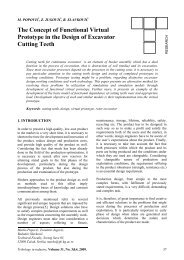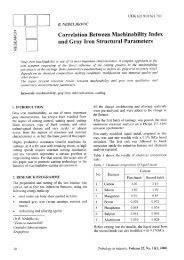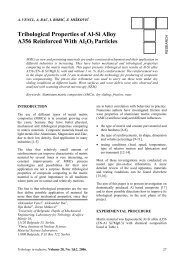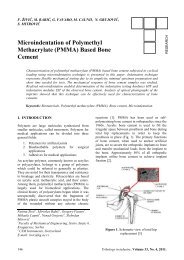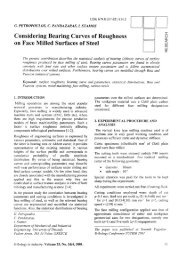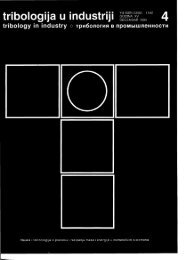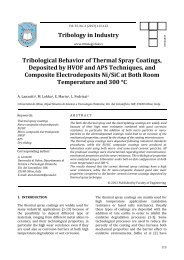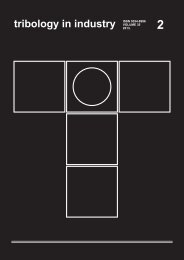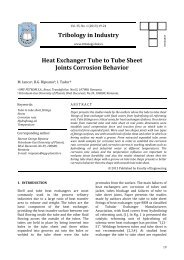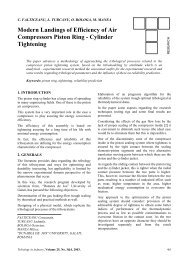No. 4, 1998 - Tribology in Industry
No. 4, 1998 - Tribology in Industry
No. 4, 1998 - Tribology in Industry
You also want an ePaper? Increase the reach of your titles
YUMPU automatically turns print PDFs into web optimized ePapers that Google loves.
nn n T<br />
o E,<br />
lrJ<br />
(t)<br />
IU<br />
E<br />
YY<br />
P. BI}ISKOWC<br />
UDK 621..919.2.ffi1.42<br />
Tribological Behaviour<br />
of Surfac<strong>in</strong>g Layers<br />
for Cont<strong>in</strong>ual Cast<strong>in</strong>g Rolls<br />
Prodactionofroobforcott<strong>in</strong>ualcast<strong>in</strong>gandroll<strong>in</strong>gmills andtheirrenovatianrepresents aphenomenonwhich<br />
is economically very srgnificant for metalluryists. It can be simply proved that the roll as a tool significantly<br />
affects the quality of rolled products and also contirudty of prodaction related to its hfe.<br />
The Weld<strong>in</strong>g Research Instilute is devoted to these problems for more than 40 years,<br />
Kcywords: Tibolog, regeneratiott, surface layer, harclen<strong>in</strong>g<br />
l.INTRODUCTION<br />
Production of rools for cont<strong>in</strong>ual cast<strong>in</strong>g and roll<strong>in</strong>g mills<br />
and their renovation represents a phenomenon which is<br />
economically very significant for metallurgists. It can be<br />
simply proved that the roll as a tool significantly affects<br />
the quality of rolled products and also cont<strong>in</strong>uity of<br />
production related to its life.<br />
In the world we ever more often encounter the metallurgical<br />
rolls with two, or even more surface layers, where<br />
the quality of work<strong>in</strong>g surface can be separated from that<br />
of base body of the roll. Such is also the pr<strong>in</strong>ciple of rools<br />
where the work<strong>in</strong>g surface is obta<strong>in</strong>ed by weld<strong>in</strong>g tech'<br />
nologies.<br />
Moreover, the new types of teel rolls [1,2], which were<br />
first succesfully used <strong>in</strong> Japan <strong>in</strong> 1986 (HSS rolls), have<br />
shown great possibilities of their renovation but also their<br />
production by weld<strong>in</strong>g technologies.<br />
The Weld<strong>in</strong>g Research Institute is devoted to these problems<br />
for more than 40 years.<br />
We shall <strong>in</strong>dicatewhat is now available forthe mentioned<br />
purposes.<br />
2. CURRENT APPLICATIONS<br />
The ma<strong>in</strong> advantage of surfac<strong>in</strong>g technolory application<br />
is a good comtrol over the process micrometallurry and<br />
consequentnly improved quality and purity of the deposited<br />
layer, and most recently also fabrication of composite<br />
weld overlays.<br />
Pavel Blalkovil,<br />
Department of Fha CoveredArc lAeld<strong>in</strong>g and Su(ac<strong>in</strong>g<br />
Weld<strong>in</strong>g Research Institute, Bratislava, Slavakia<br />
The mostly used surfac<strong>in</strong>g technolory is submerged arc<br />
process (SA). It is used for deposition of block rolls, billet<br />
rolls, pref<strong>in</strong>ish<strong>in</strong>g rolls and for the rolls of cont<strong>in</strong>ual<br />
cast<strong>in</strong>g l<strong>in</strong>es.<br />
2.1The parent material<br />
The base metal of surfaced rolls is selected from the<br />
follow<strong>in</strong>g steel types:<br />
L.0.6VoC;l.VoCr;O.3VoMo - steel <strong>in</strong> accordance with<br />
STN 42 2366.5 (Slovak Standard)<br />
2,0,8VoCL,VoCr,0.3VoMo - steel <strong>in</strong> accordance with'<br />
sTN42 2865.9<br />
3.05VoC;7VoCr - forged steel <strong>in</strong> accordance with<br />
sTN 14161<br />
4.0.6VoC - forged steel <strong>in</strong> accordance with<br />
srN 12060.9<br />
5.0.5VoC;0.8VoCr - steel <strong>in</strong> acrordance with<br />
sTN42 n39.5<br />
The choice of base metal depends on overall load<strong>in</strong>g of<br />
roll and its dimensions.<br />
2.2 Filler materials<br />
For submerged are surfac<strong>in</strong>g of the roll<strong>in</strong>g mill rolls and<br />
rolls for cont<strong>in</strong>ual cast<strong>in</strong>g the follow<strong>in</strong>g types of tubular<br />
wire and flux cored strip electrodes, <strong>in</strong>clud<strong>in</strong>g the flux<br />
comb<strong>in</strong>ation from the production of Weld<strong>in</strong>g Research<br />
Institute Bratislava, the types given <strong>in</strong> Table 1 are used.<br />
[4,6]<br />
In addition to submerged arc surfac<strong>in</strong>g of the cont<strong>in</strong>ual<br />
cast<strong>in</strong>g rolls, also open arc self-shield<strong>in</strong>g process is hpplied.<br />
The used tlpe of tubular wires are shown <strong>in</strong> Table<br />
2.[s)<br />
L54<br />
Tibologt <strong>in</strong> <strong>in</strong>dwtry, Volume 20, <strong>No</strong>. 4,<strong>1998</strong>.



